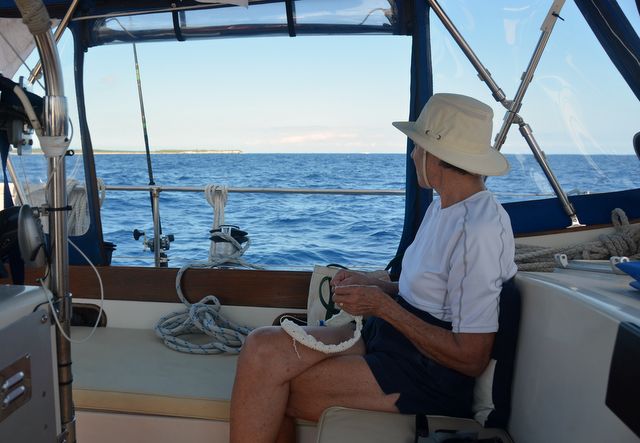
The passage: We left the dock at Cape Eleuthera Marina at 8:32AM on Saturday, January 18 with a light NW wind, a good direction for the wind, but not enough to propel us through the slight swell. We motor-sailed all day, reaching the NE tip of Cat Island at sunset. We sailed, sometimes with the rail buried, 40% of the time and motor-sailed the rest of the way to St. Martin, arriving on Saturday, January 23 at 9:30 AM. Mileage: 1006. Time: 169 hours. Average daily mileage: 143. We maintained daily contact with Chris Parker who provided helpful waypoints to keep us in the best weather possible. The last 24 hours of any long passage are the hardest, often against the wind with punishing seas. As our family in the NE US and Canada endured a blizzard of snow, we were in a blizzard of salt spray.

Our last view of Cape Eleuthera
Sunday morning we sailed through a school of flying fish. Three landed on deck, one sailing right over the aft companionway hatch, which was open. Fortunately it hit the far deck rather than falling into the aft cabin.
Tuesday night, sailing with rail under we hit some nasty waves that tore the red and green lens off our bow navigation light. We are a belt AND suspenders boat and have a tri-light nav light on top of the main mast as a backup.
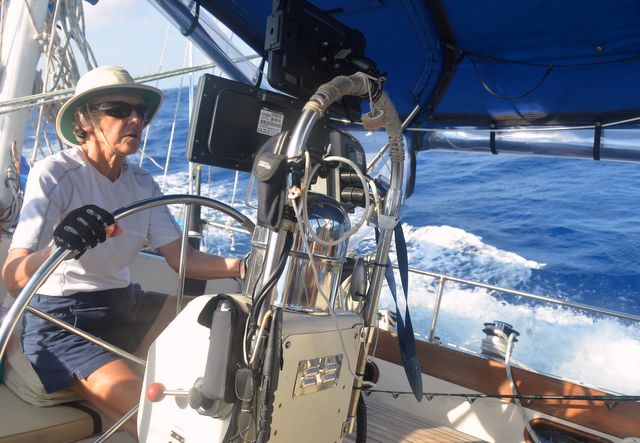
Jane hand steering through the swells and gusts
On Wednesday the flag halyard for our Canadian ensign chafed through and went sailing to the top of our mizzen mast, winding the frayed line round the SSB antenna and standing rigging, which kept us from losing the flag. The trailing edge of the Canadian ensign was in tatters, so when we were safely anchored in St. Martin, Jane climbed the mast to retrieve the flag and we replaced the flag halyard.
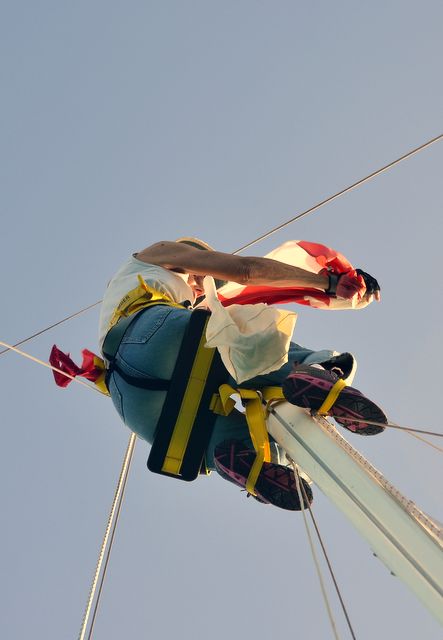
Jane doing her high wire act to retrieve an errant ensign
The centre hatch leaked, one of the chainplates near the storage area for our paper towels leaked, and a persistent, unexplainable leak in the cabinet with Jane’s underwear became active. After our 2007 Atlantic Ocean crossing, Jane has kept her undergarmets in ziploc bags, so little damage was done. When the bow of our boat is subjected to continual heavy salt spray, the dorades become flooded and drip salt water. Unfortunately one of the dorades is above our sea berth and dripped salt water on the off-watch persons ear.
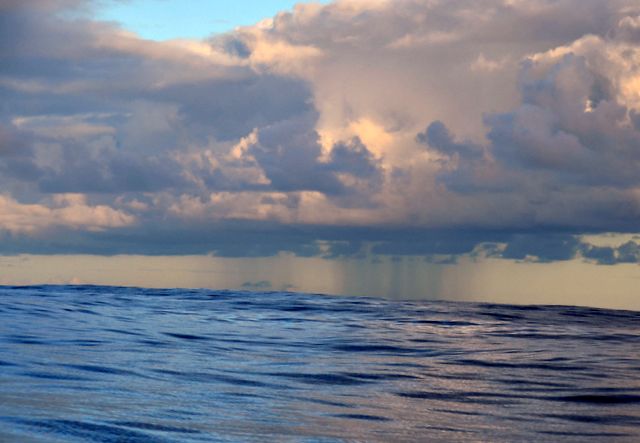
Salty or fresh … water always finds a way into the underwear drawer
St. Martin / Sint Maarten: Unlike the low-lying Bahamas with their coral reefs, the islands of the Lesser Antilles are volcanic. The older islands, Anguilla, St. Martin and St. Barths, have eroded and lie together on a large bank. But the hills of St. Martin are still relatively high which make the island visible from 15 miles out. Saba, 30 miles SE of St. Martin, is one of the younger islands and rises steeply out of the sea and was clearly visible as we approached St. Martin. The high peaks of the islands kiss the clouds. Short rain showers are common, as are the accompanying rainbows.
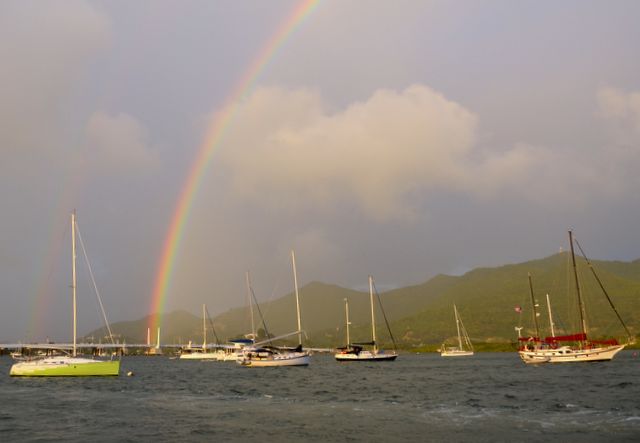
Rainbow on the colourful causeway in Simpson Bay.
The trade winds are king. The easterly and southeasterly wind is consistently 15 - 20 knots, keeping our wind generator working better than in any other location we have been. Although misty clouds form over the high peaks of the island, we have had just a few sprinkles of rain, not enough to wash off the salt. The temperature is warm, in the 80’s, but generally is not as humid as in the Bahamas and is thus more comfortable.
Whereas the Bahamas are the resort extension of the US, St. Martin is more European than North American, although on the Dutch side of the island the US dollar is the working currency and English is the working language. St. Martin is one island but 2 countries: French and Dutch. The major city on the French side is Marigot and it is full of high end shops and boutiques, a large straw market selling junky souvenirs and many restaurants from snack bars to high end establishments. The old open air fish market with its tiled basins for ice and fish is picturesque. We found only one church, a Methodist, which appeared to be closed. There was no Roman Catholic church or cathedral to be found.

Methodist Churchin Marigot
The Fort Louis Marina is high end giving shelter to high end boats. The anchorage area outside the lagoon and marina is crowded with all sizes and shapes of boats, including small cruise ships. The French side of the Lagoon has a mish-mash of boats on moorings and at anchor, some abandoned and hurricane-damaged, some permanently anchored live-aboards, and some visiting yachts. When we had a day of northerly winds, it was amazing to see the garbage float by Pilgrim from the French anchorage, including a flower pot, water-laden boards, cardboard and plastic.
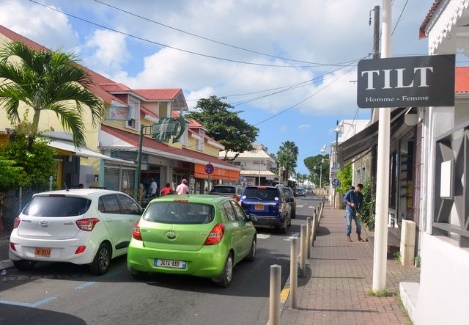
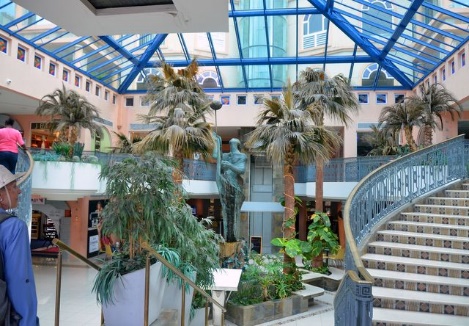
Marigot high end shopping malls and lanes (streets) filled with slow moving cars
The Dutch side does not have a clearly defined city, but is a sprawl of houses and small business establishments. There are two large chandleries, one large Ace hardware store and two large grocery stores, but spread out in the sprawl. The roads and basic infrastructure seem in some disrepair, but not in as poor condition as many areas in Cuba. We could not find any religious building, open or closed. Even though the entire island is duty-free, groceries were still pricy compared with US prices, especially for fresh fruits and vegetables?
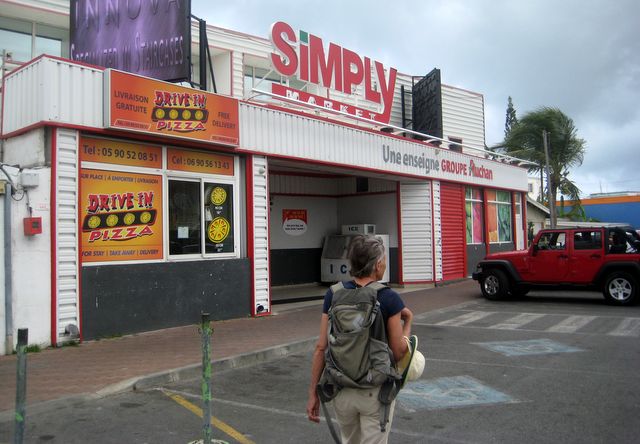
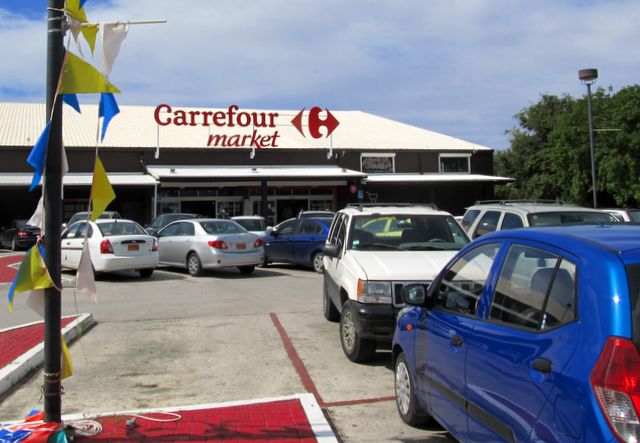
Great cheese, pate and bread at low prices …. Marigot American goods at high prices … Sint Maarten Dutch side
US and Canadian cruising boats (in the 30-50 foot range) are not as dominant as in the Bahamas. There are many Dutch, French and UK boats. The number of mega-yachts, both power and sail, is astounding. Some are anchored out, but many are at marinas in the protected lagoon harbour. They are cheek by jowl with bows anchored in the harbour and sterns tied to the quay separated by huge fenders. People walking on the deck look like midgets. Sailboats have 5 spreaders on the main mast, and 4 on the mizzen with up to 5 satellite antennas on the lower spreaders. We cannot imagine what it is like to be on one of these boats and how many weeks out of a year they are actually in use.
Megayachts packed close together and lit up at night
To the other extreme, Pilgrim was the turning mark for a group of Optimists for the youth sailing program at one of the local yacht clubs.
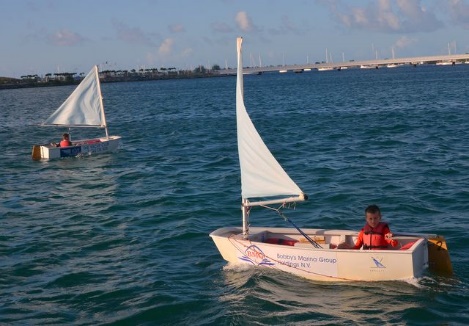
In training for the next regatta
We stayed 2 1/2 weeks in Sint Maarten, a bit longer than we planned. We missed a weather window to sail SE when Brian started investigating the leaks we experienced during our passage. He discovered potential leaks around bolts holding unused fittings, the antenna rail mounted on our aft cabin and the shore power electrical plug! The plug and wires showed black signs of arching. Fortunately two large chandleries had the parts we needed to make repairs.
Although we anchored on the Dutch side of the Lagoon, we did much of our shopping for groceries in French Marigot. We bought trays of cheese and pate ends and baguettes and had great lunch feasts until Brian’s lacto-intolerance demanded he stop. We stopped by a table in the open air market and Kevin accosted us with his sales pitch for turmeric root. We bought a bag of the roots and a few whole nutmegs. We grated the turmeric into our rice pilaf and other than getting hands and cutting board yellow, we did not detect a pronounced taste. One our last day in St. Martin we went back to the spice / vegetable stand to inquire about the quantity we should be using. Kevin was busy with other customers, but a woman asked if she could help us. I asked her about the turmeric and also about her tiny bananas, avocado and Christophene. She noticed Brian’s Canadian flag on his backpack and when she learned we lived on our sailboat we got to talking about how much we have enjoyed meeting island people on our travels. She asked if we knew the sailboat Receta. We said we knew Ann Vanderhoof who sailed on Receta and wrote An Embarrassment of Mangoes and The Spice Necklace, two excellent adventure/ cookbooks. Then the woman said, “I’m Olive.” Jane had just been reading the chapters in The Spice Necklace regarding St. Martin and felt like she already knew Olive. It is a small, wonderful world.
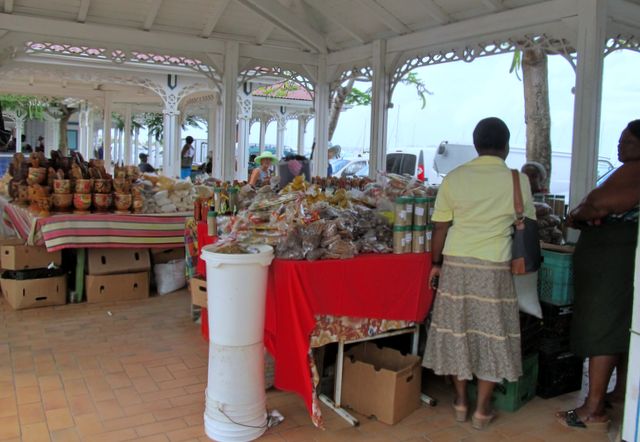
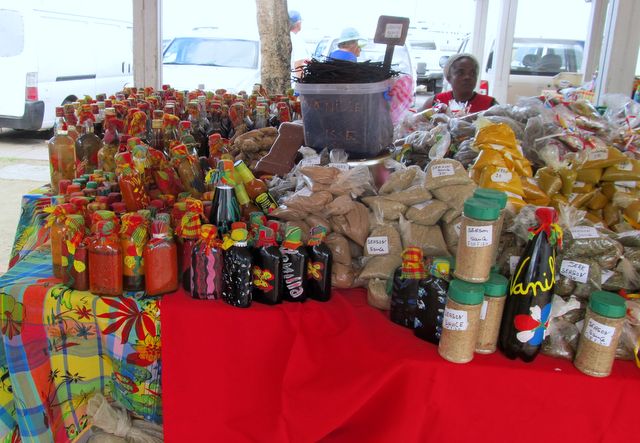
Marigot market
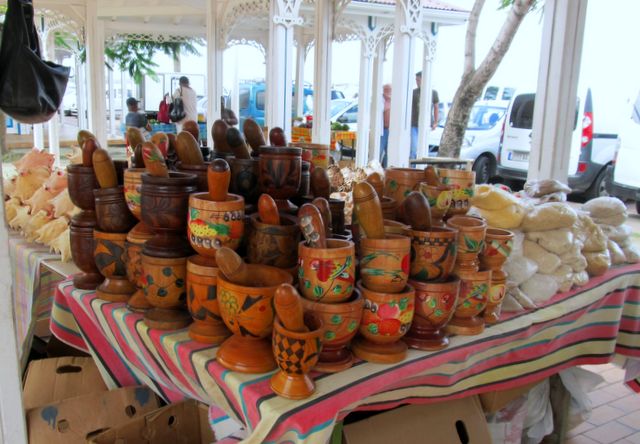
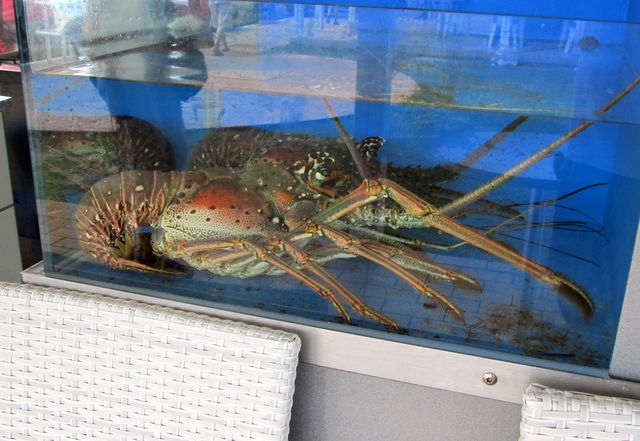
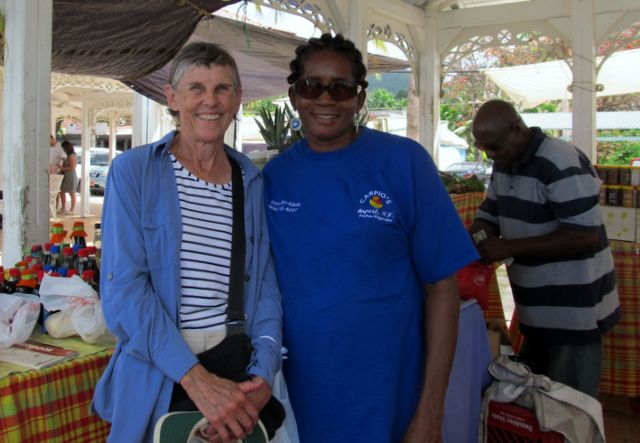
Jane and the famous Olive
During our stay the harbour has not been without accidents. The most frightening was a fire that started on a power boat at a marina. Someone was working on the gasoline tank and it caught fire. The fire was aided by a strong wind and two other boats and a boat lift were burning in short order. Billows of black smoke rose into the air. Fortunately the fire brigade was able to contain the fire to just 3 boats in the crowded harbour.
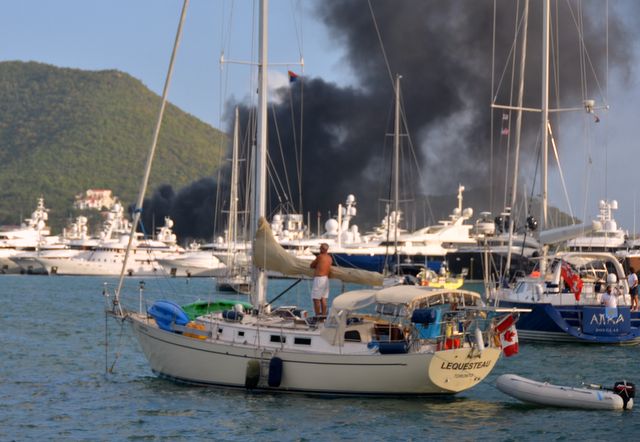
The fire that ate 3 boats
The other accidents involved anchored boats that dragged. Our second morning at anchor a squall hit us causing one boat to drag. Before the owners could take control, they were pinned against the bow of a downwind boat. Fortunately there was no significant damage to either boat and the dragging boat retrieved is weed-covered anchor and safely re-anchored. A 45-foot Norwegian catamaran did not fare as well. She dragged after sunset and ended up aground right in line with the airport runway. Several dinghies and the Coast Guard RIB tried in vain to budge the cat, but gave up after an hour. The next morning a salvage boat was able to move the catamaran off the bottom. The tidal range is only about a foot, but high tide was just enough to get the boat free. It went under its own power to a yard for haul-out inspection.
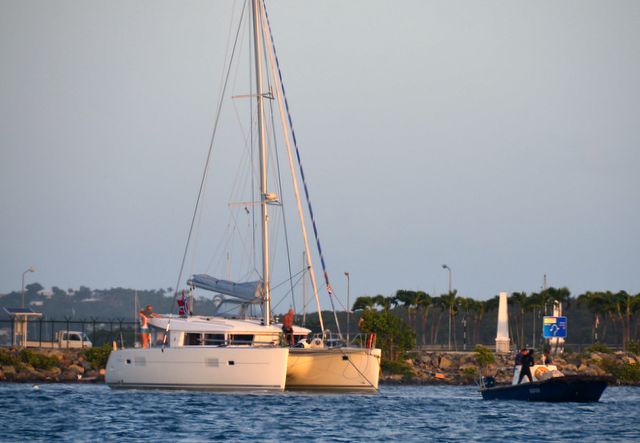
The Norwegian Cat that almost got away.